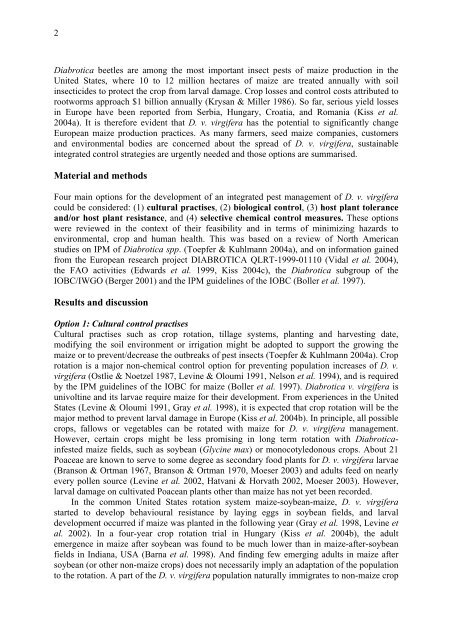IOBC/wprs Bulletin Vol. 28(2) 2005
IOBC/wprs Bulletin Vol. 28(2) 2005
IOBC/wprs Bulletin Vol. 28(2) 2005
Create successful ePaper yourself
Turn your PDF publications into a flip-book with our unique Google optimized e-Paper software.
2<br />
Diabrotica beetles are among the most important insect pests of maize production in the<br />
United States, where 10 to 12 million hectares of maize are treated annually with soil<br />
insecticides to protect the crop from larval damage. Crop losses and control costs attributed to<br />
rootworms approach $1 billion annually (Krysan & Miller 1986). So far, serious yield losses<br />
in Europe have been reported from Serbia, Hungary, Croatia, and Romania (Kiss et al.<br />
2004a). It is therefore evident that D. v. virgifera has the potential to significantly change<br />
European maize production practices. As many farmers, seed maize companies, customers<br />
and environmental bodies are concerned about the spread of D. v. virgifera, sustainable<br />
integrated control strategies are urgently needed and those options are summarised.<br />
Material and methods<br />
Four main options for the development of an integrated pest management of D. v. virgifera<br />
could be considered: (1) cultural practises, (2) biological control, (3) host plant tolerance<br />
and/or host plant resistance, and (4) selective chemical control measures. These options<br />
were reviewed in the context of their feasibility and in terms of minimizing hazards to<br />
environmental, crop and human health. This was based on a review of North American<br />
studies on IPM of Diabrotica spp. (Toepfer & Kuhlmann 2004a), and on information gained<br />
from the European research project DIABROTICA QLRT-1999-01110 (Vidal et al. 2004),<br />
the FAO activities (Edwards et al. 1999, Kiss 2004c), the Diabrotica subgroup of the<br />
<strong>IOBC</strong>/IWGO (Berger 2001) and the IPM guidelines of the <strong>IOBC</strong> (Boller et al. 1997).<br />
Results and discussion<br />
Option 1: Cultural control practises<br />
Cultural practises such as crop rotation, tillage systems, planting and harvesting date,<br />
modifying the soil environment or irrigation might be adopted to support the growing the<br />
maize or to prevent/decrease the outbreaks of pest insects (Toepfer & Kuhlmann 2004a). Crop<br />
rotation is a major non-chemical control option for preventing population increases of D. v.<br />
virgifera (Ostlie & Noetzel 1987, Levine & Oloumi 1991, Nelson et al. 1994), and is required<br />
by the IPM guidelines of the <strong>IOBC</strong> for maize (Boller et al. 1997). Diabrotica v. virgifera is<br />
univoltine and its larvae require maize for their development. From experiences in the United<br />
States (Levine & Oloumi 1991, Gray et al. 1998), it is expected that crop rotation will be the<br />
major method to prevent larval damage in Europe (Kiss et al. 2004b). In principle, all possible<br />
crops, fallows or vegetables can be rotated with maize for D. v. virgifera management.<br />
However, certain crops might be less promising in long term rotation with Diabroticainfested<br />
maize fields, such as soybean (Glycine max) or monocotyledonous crops. About 21<br />
Poaceae are known to serve to some degree as secondary food plants for D. v. virgifera larvae<br />
(Branson & Ortman 1967, Branson & Ortman 1970, Moeser 2003) and adults feed on nearly<br />
every pollen source (Levine et al. 2002, Hatvani & Horvath 2002, Moeser 2003). However,<br />
larval damage on cultivated Poacean plants other than maize has not yet been recorded.<br />
In the common United States rotation system maize-soybean-maize, D. v. virgifera<br />
started to develop behavioural resistance by laying eggs in soybean fields, and larval<br />
development occurred if maize was planted in the following year (Gray et al. 1998, Levine et<br />
al. 2002). In a four-year crop rotation trial in Hungary (Kiss et al. 2004b), the adult<br />
emergence in maize after soybean was found to be much lower than in maize-after-soybean<br />
fields in Indiana, USA (Barna et al. 1998). And finding few emerging adults in maize after<br />
soybean (or other non-maize crops) does not necessarily imply an adaptation of the population<br />
to the rotation. A part of the D. v. virgifera population naturally immigrates to non-maize crop

















